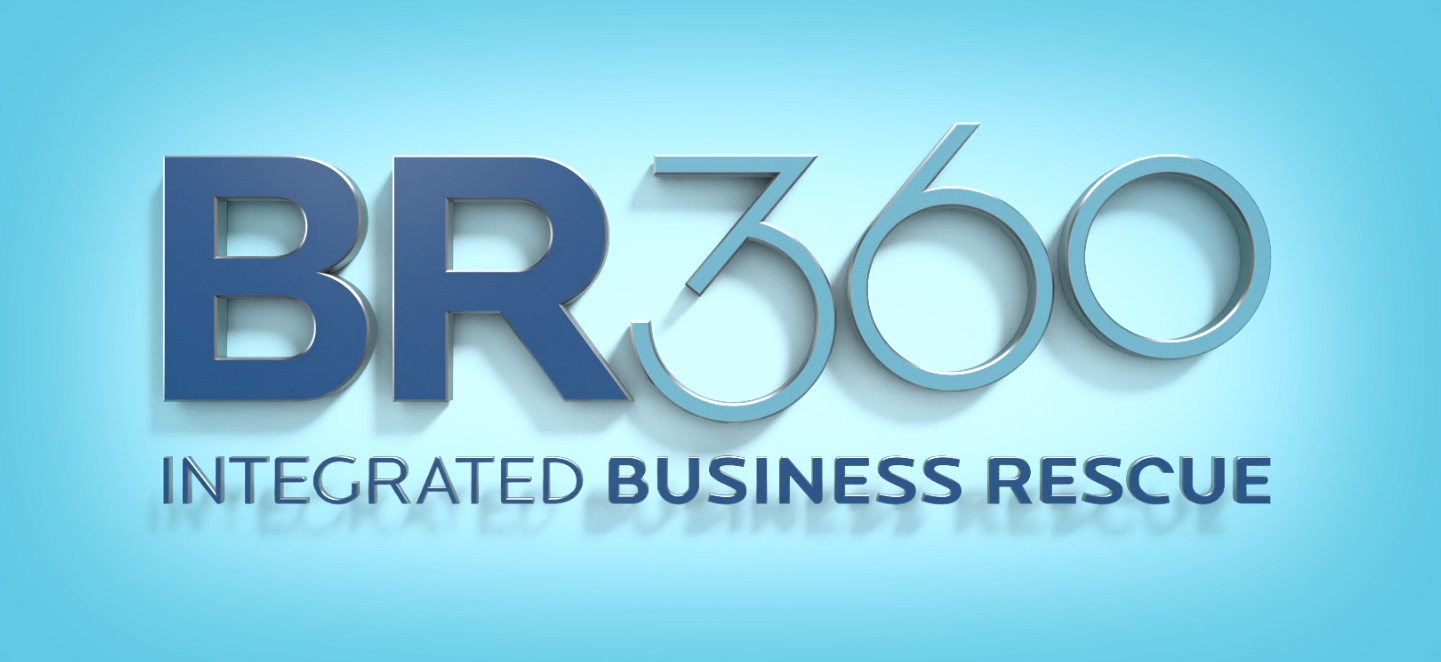WELCOME TO BR360
A corporate consulting firm, specialising in the rehabilitation, restructuring and/ or rescue of ailing businesses. Whether in financial distress or simply needing help with a creditor resolution process, look no further for a wealth of experience and knowledgeable assistance.
WHY BR360
OUR MANTRA
Rehabilitation, Restructuring, and business Rescue can be used to address numerous forms of distress – most commonly financial – but also other forms of distress such as legacy, structure and hierarchy.
OUR VISION
BR360 strives to be the pre-eminent choice for restructuring and/or rehabilitating distressed businesses in the next 18 months, while still maintaining our success rate and reputation.
OUR MISSION
Contributing to the South African economy by simply doing what we do best, saving businesses, saving jobs, and providing the best possible outcome to all affected.
SERVICES OFFERED BY BR360
- Rehabilitation
- Chief Restructuring Officer projects (CRO)
- Informal turnarounds (section 155)
- Step-in projects
- Restructuring
- Financial restructuring
- Mergers and acquisitions
- Exit strategies
- Business Rescue in terms of Chapter 6
- Debtor or creditor initiated
- Creditor assistance in navigating process
- Structured wind-down
OUR 360 APPROACH
When it comes to helping a business in distress, whether as a result of its own internal inefficiencies, or as a result of external matters beyond their control, we can help.
From our sound decision-making process and giving you all the available options, to the actual implementation of a turnaround strategy or business rescue plan, we can help.
If you’re a creditor facing non-payment from a customer in business rescue or liquidation, we can help.
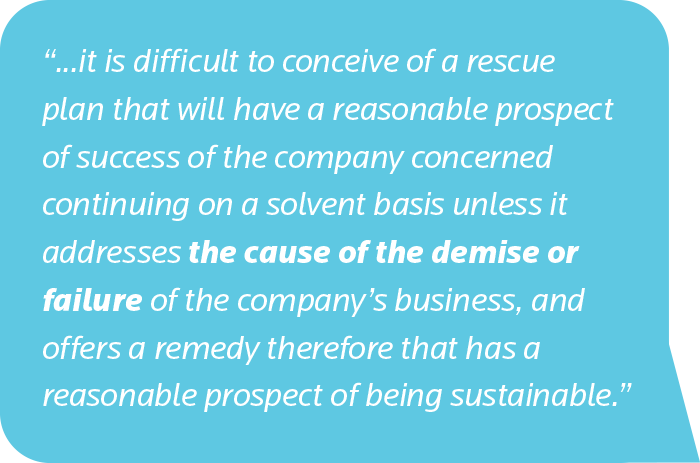
We do so with a hands-on approach, a qualified team and with our client’s best interests at the very centre of our approach. Whether from a creditor or debtor perspective, we can help in all aspects of rehabilitation.
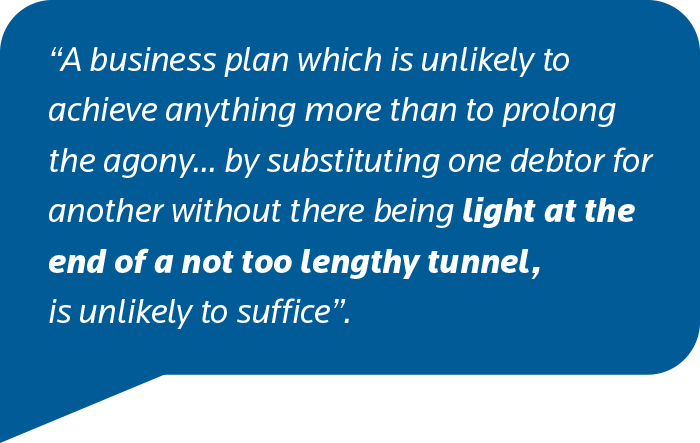
JUDGE
ELOFF
THE PROCESS
The three R’s are all processes that can help companies improve their operations in order to improve financial performance. However, there are some key differences between the three processes.
The role of Rehabilitation
REHABILITATION is a process in which a company attempts to address certain historical inefficiencies that have either crept in over time or materialised as a result of changes; and/or the environment it operates in; complacency; internal differences of opinion/strategy; lack of standardisation, outdated systems and processes; or simply poor management practises.
As with any of our processes, the first step is identification, and this is where our proprietary business health check provides us with a competitive advantage. Our system enables us to quickly identify areas of possible improvement, allowing us to address these areas timeously and effectively.
From the South Gauteng High Court:
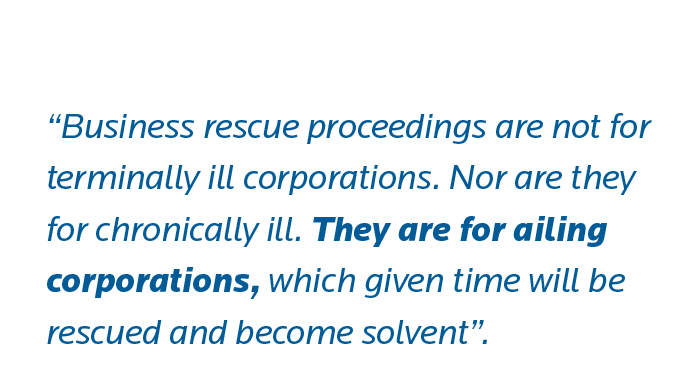
Areas of improvement most commonly include:
- Legacy – what has always worked is now outdated and needs to be replaced.
- Product profitability – analysis may identify direct or indirect loss makers, that are not easily identifiable from financials alone.
- Poor management practices – this could include lack of clear communication, poor decision-making, or lack of accountability, resulting in inefficiencies and low employee morale.
- Market positioning – the company may be facing intense competition, or unplanned market changes of reverse economies of scale.
- New technologies – the company many not be using up-to-date technology, which can make it difficult to compete and adapt in the market.
- Human Resources issues – these could result in a lack of skilled workforce, or poor employee morale stemming from overly robust or too lenient a management style; or simply as a result of the company’s inability to adapt to an ever-changing employment landscape.
- Financial problems – these could result in high debt, low profitability, or cash flow issues, which can hinder the ability to operate and grow.
Rehabilitation typically involves a thorough investigation of the company’s current operations in addition to most recent changes. This gets done through the lens of the industry it operates in and historical outcomes versus future desired outcomes.
The role of Corporate Restructuring
CORPORATE RESTRUCTURING is the process of the deliberate reorganizing of a company’s internal structure, operations, ownership, or combination thereof. It’s done to improve the company’s performance, operational efficiency, to unlock value, or to adapt to changes in the market or industry.
This can include changes such as downsizing, divestitures, mergers, acquisitions, expansion and/or changes to the company’s management structure or ownership.
|
1
|
Organizational re-design – facilitating the formalisation of a structure and hierarchy within a company to realign the company and its key stakeholders with updated goals and objectives. |
|
|
|
|
2
|
Leadership development – identifying, training, and developing current and / or future leaders within a company to help drive its updated goals and objectives. |
|
|
|
|
3
|
Operations management restructure – managing, measuring and adapting the day-to-day operations of the company to ensure efficiency and effectiveness. |
|
4
|
Cost management – identifying and reducing unnecessary costs within a company to improve its bottom line, without inhibiting its operations. This process also identifies areas where the business should invest or even re-invest capital to secure future profitability. |
|
|
|
|
5
|
Talent management – identifying, recruiting, developing, and retaining top talent within a company. Often top management needs to be replaced in a very short period of time, necessitating the employment of interim directors or other key staff members. |
|
|
|
|
6
|
Process improvement – identifying and removing inefficient or ineffective processes within a company to increase efficiency, productivity and ultimately profit. |
|
|
|
|
7
|
Performance management – measuring, evaluating, and improving the performance of processes, employees and / or teams within a company. |
Restructuring is typically a more formal process than rehabilitation, and while it may resort to the involvement of a court or other third party, it remains a more confidential process than business rescue.
The role of business rescue
BUSINESS RESCUE is the formal and legal process, as contained in Chapter 6 of the Companies Act, for the rehabilitation of a financially distressed business.
Business Rescue is a process geared towards the rehabilitation of a business in financial distress. The process of Business Rescue provides for the temporary supervision of the business in order to restructure it in a way that is beneficial to all affected persons, but at a minimum, securing a better outcome than that of an immediate and traditional liquidation.
“The aim of business rescue is to restructure the affairs of a company in such a way that either maximises the likelihood of the company continuing in existence on a solvent basis or results in a better return for the creditors of the company than would ordinarily result from the liquidation of the company (section 128(1)(b)(iii)).”
Business Rescue is a process introduced by Chapter 6 of the Companies Act of 2008, and its aim is clearly stated in Section 128 (1)(b)(iii) of the Act. Its definition is made up of two parts:
|
1
|
The first part of the definition of Business Rescue states that it is a process designed to rehabilitate financially distressed companies. |
|
|
|
|
2
|
The second part of the definition is that if a turnaround of the Business is not possible, that the Business Rescue process must provide a better return to creditors and shareholders than what would be realised through the immediate and traditional liquidation of the Business. This is done via a temporary supervision of the Business by a Business Rescue Practitioner, where this practitioner must determine the exact financial position of the Business and prepare a Proposed Business Rescue Plan which creditors will ultimately vote on. |
For a Business to qualify for Business Rescue, it needs to meet two requirements stipulated in as Section 129 (1) of the Act.
|
1
|
The first requirement is that the Business must be financially distressed as defined in Section 129 (1)(a) of the Act. |
|
|
|
|
2
|
The second requirement is that the Business Rescue Practitioner must be of the opinion that a reasonable prospect of a rescue exists as defined in Section 129 (1)(b) of the Act, alternatively the practitioner must be in a position to provide a better outcome to the creditors and affected persons than what would be realized in a liquidation scenario. |
Although Business Rescue is never a first choice, it remains a powerful tool to any business owner or director in South Africa. Understanding business rescue and ensuring that you have the correct practitioner on board is vital to the success of any Business Rescue engagement.
Tools of a Business Rescue practitioner
Chapter 6 allows for several tools that the Business Rescue Practitioner or (BRP) can use to achieve a successful rehabilitation of the company in financial distress. These include:
|
1
|
Moratorium on all legal proceedings – Section 133 of the Companies Act makes provision for a general moratorium on all legal proceedings against the company. This means that during business rescue proceedings, no legal proceedings may be commenced or proceeded with against the company. This protection gives much needed breathing space to assess the business holistically, and to focus the attention of the management team and the business rescue team on what’s needed to ensure a successful business rescue intervention. |
|
|
|
|
2
|
Release from debt – Section 151 of the Companies Act makes provision for a Business Rescue Practitioner to include in the business rescue plan an offer as full and final settlement to creditors. This includes either a compromise relating to Cents in the Rand with immediate payment or a repayment over an extended period of time, or a combination of a compromise over an extended repayment period. |
|
3
|
Suspension of contracts – The Companies Act makes provision in Section 136 that the Business Rescue Practitioner may suspend certain contracts that the business is party to, either partially or in full. This is done only for the duration of the business rescue proceedings. This section was included to assist the business to suspend contracts that negatively affect the business, and which would not be able to be suspended under normal trading conditions. However, to have a contract completely cancelled, the BRP must apply to court for an order to cancel the contract where it is not beneficial to the company. The only exception to this section is employment contracts, which may not be cancelled except in terms of the Labour Relations Act sections 189 and 189A. |
|
|
|
|
4
|
Opportunity to re-structure – The process of business rescue gives the Business Rescue Practitioner and existing management the opportunity to restructure the affairs of the business in order to improve its operations, and ultimately, profitability and future prospects. The overall aim of business rescue is to save jobs, but the rights of all affected persons must be balanced. |
The Team
Business Rescue 360 is able to offer an all- round, problem-solving and solution- based approach because of the team at its core. Business rescue depends on connecting a wide range of talent and experience as well as legal and financial skills to both plan and execute successful outcomes.
It is this wide diversity of knowledge, plus the proven ability to arrive at workable solutions in difficult, high pressure situations that allows us to define what needs to be done, and as quickly as possible.
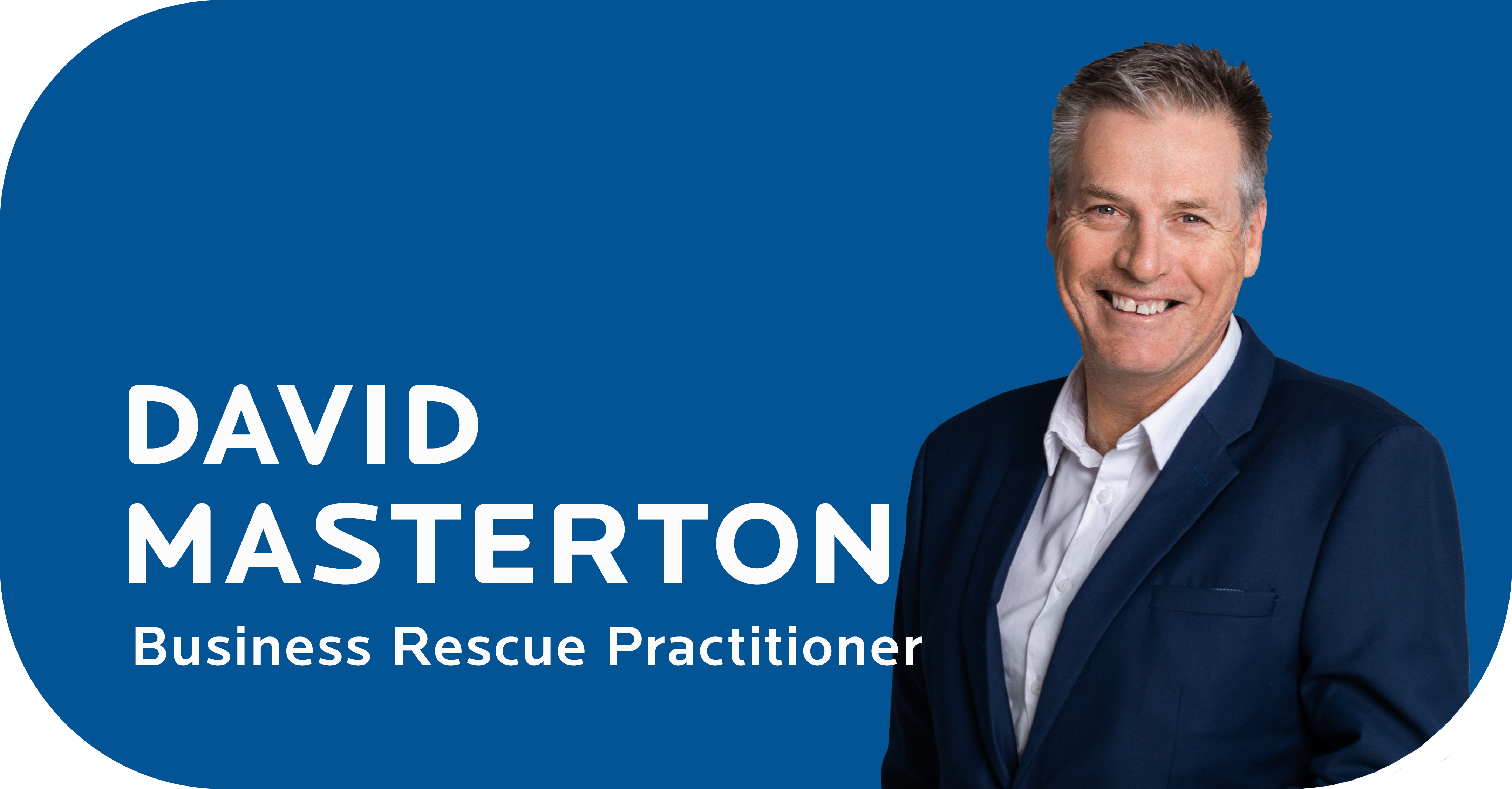
DAVID MASTERTON | DIRECTOR
BCompt (Hons) CA (SA) CFE MDP B‑BBEE
David is a Chartered Accountant with extensive knowledge of a broad spectrum of advisory roles.
In his 8 years career with SAPPI as Commercial Manager, he built valuable experience of supply chain management, work flow and system implementation.
David joined Nolands in 2013 in that time has assumed leadership in several aspects of the company’s business, including advising clients on BBEEE strategy, re-structure, M&A and in identifying opportunities and initiating start-ups.

WALTER GEACH | CHAIRMAN
BA LLB (UCT) MCom FCIS CA (SA)
Prof Walter Geach is uniquely qualified and experienced in the fields of trusts, taxation and estate planning. He is a chartered accountant CA (SA), an admitted advocate of the High Court and former Head of the Department of Accounting at UWC. Among his many other academic achievements, he has also authored/co-authored over 15 published books which have become go-to reference works in the industry. He is a director (non-exec) on several boards, including Grand Parade Investments Ltd.

PAT PATTINSON | BUSINESS RESCUE PRACTITIONER
Since 2011, Pat has been appointed to more than 50 formal businesses rescue assignments in various industries throughout South Africa. He has achieved an outstanding success rate of more than 90% on published business rescue plans.
In December 2015 he was officially promoted to a Senior Business Rescue Practitioner and at the end of 2018 was accredited as a Professional Turnaround Practitioner SA (PTP-SA SAQA)He is currently the COO of the Turnaround Management Association of South Africa (TMA-SA).
He has broad experience in business, finance and law.
CONTACT US
If you believe it to be in your company’s best interest to explore any aspect of the topics raised here, we invite you to get in touch with David Masterton for a completely confidential chat, without any obligation whatsoever. His contact details are on the right.
Alternatively use the messaging form below and we will get back to you.

